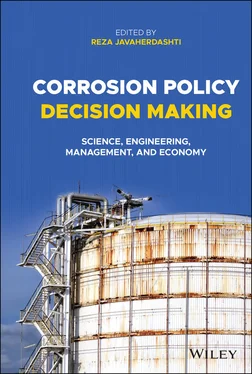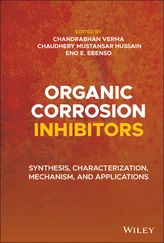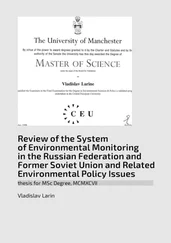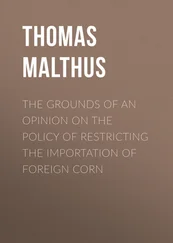Corrosion Policy Decision Making
Здесь есть возможность читать онлайн «Corrosion Policy Decision Making» — ознакомительный отрывок электронной книги совершенно бесплатно, а после прочтения отрывка купить полную версию. В некоторых случаях можно слушать аудио, скачать через торрент в формате fb2 и присутствует краткое содержание. Жанр: unrecognised, на английском языке. Описание произведения, (предисловие) а так же отзывы посетителей доступны на портале библиотеки ЛибКат.
- Название:Corrosion Policy Decision Making
- Автор:
- Жанр:
- Год:неизвестен
- ISBN:нет данных
- Рейтинг книги:4 / 5. Голосов: 1
-
Избранное:Добавить в избранное
- Отзывы:
-
Ваша оценка:
- 80
- 1
- 2
- 3
- 4
- 5
Corrosion Policy Decision Making: краткое содержание, описание и аннотация
Предлагаем к чтению аннотацию, описание, краткое содержание или предисловие (зависит от того, что написал сам автор книги «Corrosion Policy Decision Making»). Если вы не нашли необходимую информацию о книге — напишите в комментариях, мы постараемся отыскать её.
Explore the science, management, economy, ecology, and engineering of corrosion management and prevention Corrosion Policy Decision Making
Corrosion Policy Decision Making
Corrosion Policy Decision Making — читать онлайн ознакомительный отрывок
Ниже представлен текст книги, разбитый по страницам. Система сохранения места последней прочитанной страницы, позволяет с удобством читать онлайн бесплатно книгу «Corrosion Policy Decision Making», без необходимости каждый раз заново искать на чём Вы остановились. Поставьте закладку, и сможете в любой момент перейти на страницу, на которой закончили чтение.
Интервал:
Закладка:
Discussing enough about economics as required to define corrosion damage is addressed in Chapter 4, whereas environmental effects of corrosion has been addressed in Chapter 7.
This book is highly likely to experience a “Semmelweis Reflex” which essentially means “to stick to preexisting beliefs and to reject fresh ideas that contradict them [2]. No literature of CM known to us issues such details of economy, environment, TRIZ, and innovative interpretation of CM as we will cover in this text.
References
1 1 Aquinas, P.G. (2011). Principles and Practices of Management. Phagwara, India: Lovely Professional University.
2 2 Gupta, V. K., Saini, C., Oberoi, M. et al. (2020) “Semmelweis Reflex: An Age‐Old Prejudice,” World Neurosurgery. https://pubmed.ncbi.nlm.nih.gov/31837492, last visited 13 February 2021.
Notes
1 1Please study Chapter 3for a better understanding of these terms.
2 2The metallic path when referred to corrosion under real life conditions has no meaning because corrosion already is taking place on metals.
3 3 https://www.defenseindustrydaily.com/Sen‐Tom‐Coburn‐Americas‐Fiscal‐Defense‐Crisis‐06412, last visited 15 February 2021.
4 4Corrosion prevention and corrosion control are not the same and cannot be used interchangeably. We will get back to this concept later in this book.
2 A Short Review of Some Important Aspects of the Science of Corrosion
Reza Javaherdashti1∗ and Ali Ghanbarzadeh2†
1 General Manager, Eninco Engineering B.V., The Netherlands
2 Research at RIPI (Research Institute of Petroleum), I.R. Iran
2.1 Introduction
Corrosion is a process that happens naturally. The way corrosion happens is a story that has been repeated in all books written on the subject, but it will still make sense if we repeat it here. The main reason for doing so is that the thermodynamics behind corrosion is not only important from a scientific/engineering point of view, but also from a corrosion management (CM) approach. (We have described the significance of the thermodynamic nature of corrosion and how it is important in engineering practices, and particularly CM and management of corrosion in Chapter 3.)
Corrosion is derived from a Greek word that may be translated as “bitten away.” Some authors—including us—justify this word by implying that a corroded part seems to have been bitten. The invisible bite probably comes from the very nature of the metal because metals are not found in their pure form—that is without having oxides, sulfates, carbonates, and the like—in their natural form. Even what we call iron (that originally means “coming from heaven” probably due to it being mainly found in meteors) is not naturally found as a totally pure material free of non‐metallic materials. Metals such as iron, copper, and the like are always found in their ores. Ore is a rock part that contains these metals as compounds and not elements. These rocks are extracted and crushed and the metallic compounds within them are then extracted. The second and the most important stage from a corrosion point of view, however, is the extraction of metal from the “surrounding” non‐metallic compounds around it. The core process in metal extraction is the reduction processes during which electrons are added to electrons already existing in the metal element itself. These reduction processes, collectively referred to as “extraction metallurgy processes” are basically those happening in metallurgy plants. It is by these processes that metals with high purity are being produced.
In this sense, the pure metal is not at rest when compared to its state when it was in its ore. In other words, the state of energy in two stages of “in‐ore” and “as‐extracted” will be far different from each other; Gibbs free energy of “in‐ore” is much lower than that of “as‐extracted.” This means that any way by which this excess of energy can be released will favor corrosion.
Now that it is understood that the force by which corrosion is being driven comes from the very nature of materials, particularly metals, we need to understand some basic concepts upon which the whole electrochemical corrosion principles are based. Why electrochemical corrosion? It is because a number of corrosion processes ranging from corrosion under insulation to microbiologically influenced corrosion (MIC) to atmospheric corrosion are all gathered under the umbrella of electrochemical corrosion. Therefore, in this chapter, we will review and describe some fundamental aspects of electrochemical corrosion, what it is, and how it can be treated. As we will see in Chapter 3about “smart management of corrosion,” prevention of corrosion is different from corrosion control. Very briefly, prevention of corrosion can be applied to a Greenfield project related to corrosion, or equipment which is still too young in its service life so that options such as modification of design or materials selection/upgrade or even change and modification of process parameters have yet to be considered. Corrosion control, on the other hand, is applied to a Brownfield project or equipment which has been in service for a quite long time (perhaps more than a year), so that not only are any change or modification in any process parameters not permissible, but also options such as change of design or materials selection can be highly likely to be considered too costly to be applied. By “corrosion treatment” we address both corrosion control and corrosion prevention where applicable, per case.
We will therefore start with very definition of the elements of an electrochemical corrosion process and continue with available tools to predict corrosion, that is, to foresee if it will occur or not, and then we continue with five treatment approaches toward corrosion. The five approaches are (i) chemical treatment, (ii) electrical treatment, (ii) mechanical treatment, (iv) design/material selection, and (v) physical treatment. What we have to advise from the beginning is that the fourth treatment approach can still be an option even if the problem is categorized as a corrosion control issue. In this regard, it is the cost of application that will be the major playing factor if design/material selection is to be better applied for a corrosion control approach.
Our approach in this section may sound somewhat radical to those who have been used to reading materials in their usual context, because instead of being too academic, our understanding of corrosion theory and practice is directly focusing on its pragmatic, immediate benefits for the readers and whoever engaged in the so‐called CM practice. We would not allow our readers to be, literally, buried under formulas, diagrams, and the like. We want to be straight‐forward and write frankly!
2.1.1 Essentials of Electrochemical Corrosion
If corrosion is a natural process by which energy of the system is lowered, then any approach toward corrosion must be the same when facing any natural process. The main thing here, however, is that as long as corrosion has not been allowed to make a hole in an asset—the process we call through‐wall pitting—it is safe. This approach may sound quite different from what we have been taught so far; any manual on CM starts with the unwritten assumption that the job for a corrosion engineer is to prevent corrosion. In fact, the job of a corrosion engineer—and for that matter an integrity management expert—is to prevent through‐wall pitting occurrence as manifested by severe, localized corrosion.
Figure 2.1shows an example of two assets that have been severely corroded through localized corrosion. In both of the figures there are three elements of corrosion that can be recognized. The anode is the spot at which anodic reaction occurs, and in cases similar to those shown in Figure 2.1, it is where sever pitting in the form of severe through‐wall pitting happens. At the anode, electrons are being released and travel via the metallic material body toward the cathode, the cathode could be adjacent to the anode. However, the point is that in localized corrosion, contrary to uniform corrosion, anode and cathode spots do not move relative to each other, so that the anode is fixed and from the very spot the anode becomes fixed, pitting starts. It is also due to this feature that localized corrosion happens in one particular spot on the metallic structure. This may also be the main characteristic of localized corrosion that makes its prediction almost impossible; one cannot know where that attack will occur and with what severity, normally measured in terms of corrosion rate and expressed by pitting factor, it can occur. The moisture on the metallic surface that is basically the water vapor already available in the air will be the main electrolyte through which ion exchange can happen.
Читать дальшеИнтервал:
Закладка:
Похожие книги на «Corrosion Policy Decision Making»
Представляем Вашему вниманию похожие книги на «Corrosion Policy Decision Making» списком для выбора. Мы отобрали схожую по названию и смыслу литературу в надежде предоставить читателям больше вариантов отыскать новые, интересные, ещё непрочитанные произведения.
Обсуждение, отзывы о книге «Corrosion Policy Decision Making» и просто собственные мнения читателей. Оставьте ваши комментарии, напишите, что Вы думаете о произведении, его смысле или главных героях. Укажите что конкретно понравилось, а что нет, и почему Вы так считаете.












